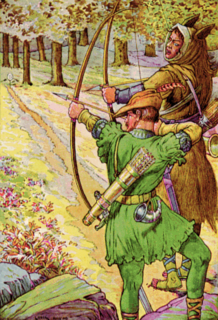
Little John is a companion of Robin Hood who serves as his chief lieutenant and second-in-command of the Merry Men. He is one of only a handful of consistently named characters that relate to Robin Hood and one of the two oldest Merry Men, alongside Much the Miller's Son. His name is an ironic reference to his giant frame, as he is usually portrayed in legend as a huge warrior - a seven-foot-tall master of the quarterstaff.

Sir Guy of Gisbourne is a character from the Robin Hood legends of English folklore. He first appears in "Robin Hood and Guy of Gisborne", where he is a hired killer who attempts to kill Robin Hood but is killed by him. In later depictions, he has become a romantic rival to Robin Hood for Maid Marian's love.
The Bishop of Hereford is a character in the Robin Hood legend. He is typically portrayed as a wealthy and greedy clergyman who is robbed by Robin and his Merry Men.
Alan-a-Dale is a figure in the Robin Hood legend. According to the stories, he was a wandering minstrel who became a member of Robin's band of outlaws, the "Merry Men".
Will Scarlet is a prominent member of Robin Hood's Merry Men. He is present in the earliest ballads along with Little John and Much the Miller's Son.

The Merry Adventures of Robin Hood of Great Renown in Nottinghamshire is an 1883 novel by the American illustrator and writer Howard Pyle. Consisting of a series of episodes in the story of the English outlaw Robin Hood and his band of Merry Men, the novel compiles traditional material into a coherent narrative in a colorful, invented "old English" idiom that preserves some flavor of the ballads, and adapts it for children. The novel is notable for taking the subject of Robin Hood, which had been increasingly popular through the 19th century, in a new direction that influenced later writers, artists, and filmmakers through the next century.
Will Stutely or Will Stutly is in English folklore a prominent member of Robin Hood's Merry Men. He was possibly confused with Will Scarlet because of the similarities in their surnames.
"Robin Hood and Queen Katherine" is Child ballad 145. "Robin Hood's Chase", Child ballad 146, takes up after it.
"Robin Hood and the Curtal Friar" is Child Ballad number 123, about Robin Hood.
Robin Hood and the Tinker is Child Ballad 127.
Robin Hood and the Butcher is a story in the Robin Hood canon which has survived as, among other forms, a late seventeenth-century English broadside ballad, and is one of several ballads about the medieval folk hero that form part of the Child ballad collection, which is one of the most comprehensive collections of traditional English ballads. It may have been derived from the similar Robin Hood and the Potter.
Robin Hood Newly Revived is Child ballad 128, and an origin story for Will Scarlet.
Robin Hood's Delight is Child ballad 136. It is a story in the Robin Hood canon which has survived as, among other forms, a late seventeenth-century English broadside ballad, and is one of several ballads about the medieval folk hero that form part of the Child ballad collection, which is one of the most comprehensive collections of traditional English ballads.

"A Gest of Robyn Hode" is an old English folk ballad, listed as Child Ballad 117 and number 70 in the Roud Folk Song Index; it is also called A Lyttell Geste of Robyn Hode in one of the two oldest books that contain it. As a folk song, it is not known to have survived long enough in the oral tradition to be collected by folklorists.
David of Doncaster is a member of Robin Hood's Merry Men in English folklore. Doncaster is a town near Barnsdale, where early ballads placed Robin Hood.
Arthur a Bland is, in English folklore, a member of Robin Hood's Merry Men, though his chief appearance is in the ballad in which he joins the band. Arthur a Bland is also the name of an ex British Waterways tug.
The Bold Pedlar and Robin Hood is Child ballad 132, featuring Robin Hood. It is a traditional version of Robin Hood Newly Revived.
Robin Hood and the Pedlars is Child ballad 137.

The Merry Men are the group of outlaws who follow Robin Hood in English literature and folklore. The group appears in the earliest ballads about Robin Hood and remains popular in modern adaptations.

Robin Hood and Little John is Child ballad 125. It is a story in the Robin Hood canon which has survived as, among other forms, a late seventeenth-century English broadside ballad, and is one of several ballads about the medieval folk hero that form part of the Child ballad collection, which is one of the most comprehensive collections of traditional English ballads.





